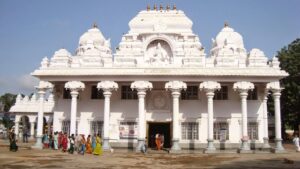
Kaiwara, a historic town in the Chikkaballapura district of Karnataka was known as Kaiwara Nadu in the bygone ages. Kaiwara existed right from the Satya-yuga and has been a holy city and a pilgrim center since then.
Kaiwara means glorifying the Supreme Lord with prayers and hymns. In this regard, the sixth canto of Bhagavata Purana mentions that in Satya-yuga, Indra after killing Vritrasura installed Deities of Lord Narayana in five places – Sri Amara Narayana in Kaiwara, Sri Narayana in Bedivere, Sri Veera Narayana in Yadokodi, Sri Adi Narayana in Yallodi and Sri Lakshmi Narayana in Gadag to get rid of the sin of killing Vritrasura as he was a devotee of lord Vishnu.
These Deities were installed at the same muhurta in the temples. However, Indra personally installed the Deity of Lord Narayana with his consorts Sridevi and Bhudevi in Kaiwara; therefore, the Lord was named Sri Amara Narayana. Amara is another name of Indra.
According to the local legends, Lord Ramachandra visited Kaiwara twice. Once with Vishwamitra when He was on a mission to protect the yajnas being performed by the rishis and the second time with Sita and Lakshmana during their exile. There is a cave known as Ramara Guhe in the temple of Amara Narayana. It is believed that Lord Rama stayed in this cave. There is a temple of Veeranjaneya on the outskirts of Kaiwara.
On a nearby hill, Lakshmana shot an arrow in order to get water to quench the thirst of Mother Sita. A small lake is formed at this place which is known as Lakshmana Tirtha. Next to Lakshmana Tirtha is the temple of Goddess Chamundeshwari. After killing the demon Mahishasura, mother Chamundeshwari visited this tirtha, took bath in its holy waters and assumed a peaceful form.
In Dwapara-yuga, Kaiwara was known as Ekachakrapura and was dwelling of Pandavas during their exile. Bhima after killing Bakarsura installed a shiva-linga to get rid of the sin which is famous as Sri Bhima Lingeshwara. Surrounding the Bhima Lingeshwara, other four Pandavas also installed lingas and worshiped them. They are called as Dharmalingeshwara, Parthalingeswara, Nakuleshwara and Sahadevalingeshwara. A temple dedicated to Parvati, the consort of Lord Shiva is also nearby. Hence Kaiwara became famous as Pancha-linga Kshetra.
In the current days, Kaiwara is famous for Sri Yogi Naraeyana Yathindra popularly known as Kaiwara Thataiyya. Thataiyya lived between 1726 and 1836 and was a bilingual devotee poet of Lord Amara Narayana. He wrote in Telugu and Kannada languages. His most popular literary contribution is Kalajnana, a prophetic text. His other works include Tattva Kirtanas, Sri Krishna Charitha Tattvamitra Yogasara and a half dozen shataka verses. He has also composed eighteen kirtanas in Kannada language which are considered on par with the kirtanas of Purandaradasa and Kanakadasa.
The Yogi Naraeyana Ashrama at Kaiwara is now carrying forward the legacy of Kaiwara Thataiyya by promoting the kirtanas and performing various social activities.
The piligrims visit the Amar Naryana temple, the Ramara guhe, the Bhimalingeshwara temple and the Tattaya Samadhi.
Source:
http://www.tirthayatra.org/kaiwara/
https://en.wikipedia.org/wiki/Kaivara
http://diksoochi.blogspot.in/2011/11/amaranarayana-temple-kaivara.html
http://interludejourney.com/2015/11/24/trek-to-bhima-bakasura-betta-in-kaiwara/
https://mytravelling.quora.com/Kiawara-Ekachakrapura
https://thinkbangalore.blogspot.in/2017/05/kaiwara-amaranarayana-swamy.html#.Wio1pVWWbIU
http://kaiwarayogi.blogspot.in/


